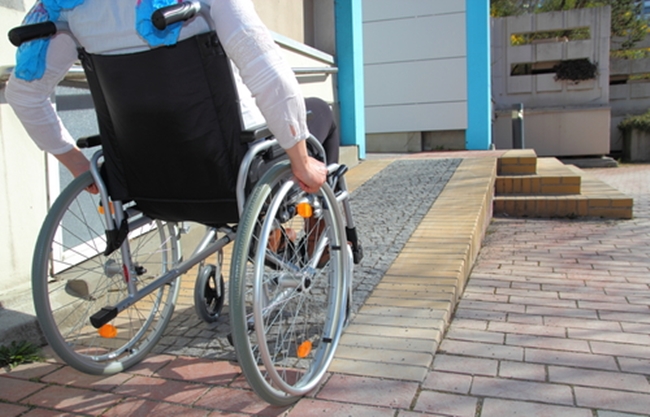
A home is a place of comfort, warmth, and peace. Making your home disability-friendly means making it accessible to anyone including people with limited mobility.
It’s not a difficult task to accomplish as there are multiple ways to attain this, and there are many disability-friendly assistive devices that you can use to make your physically challenged family member, friend, or guest move with ease.
Even without full remodeling, you can retrofit your home to make it handicap-accessible.
Here are some tips that you can work on:
1. The main entrance must have a ramp.
The main entrance is the first struggle of people on wheelchairs and walkers because many houses have front steps. A wooden, concrete or aluminum ramp can allow easy access. Apply non-slip strips to ensure that the surface is resistant to slipping.
There are many types of ramps, but arguably the most convenient to use is a portable ramp. You can unfold and store it according to the need.
2. Widen the doorways.
A person in a wheelchair must be able to move freely through a doorway. The doorframes must measure at least 32 inches wide to accommodate a wheelchair.
Most doors have enough space for widening. If it’s tight, swing-away hinges can do the job as it adds a few inches.
For small bathrooms, install the door to swing outwards.
3. The switches must be easy to reach.
Install the light and thermostat switches lower. Another option is to put additional switches that are more accessible to people with disabilities.
For more convenience, replace the light fittings with remote control products.
4. Make the bathroom easy to use.
You can do this alteration by converting the bathroom into a “walk-in shower”. It will significantly reduce the risk of people falling. Replace the toilet with a disability-friendly type, or you can install a raised seat for a more practical solution.
Grab bars can also provide stability while in the bathroom.
5. Replace the doorknobs with pull handles.
People with disabilities and elderlies often find doorknobs to be a nuisance. Pull handles are more comfortable to use. These handles are cheap and easy to install. You can also do this modification on faucets and taps. Lever handles on faucets can also be an alternative.
6. Arrange everyday items from high to low cabinets.
People with mobility issues may have difficulty getting items from a high cabinet. Move everyday items, such as dishes, towels, and toiletries, to lower cabinets to provide easy accessibility.
7. Consider moving your furniture to give way to people on wheelchairs or walkers.
A person in a wheelchair must also move freely inside the house. Just like the width of the doorway, you can move your furniture and allot at least 32 inches of space in between.
8. Rethink your home’s flooring.
Thick carpeting and rugs can cause difficulties in maneuvering for people with disabilities. People on walkers could trip on this type of material.
To reduce the risks of carpet accidents, consider installing hardwood, tile, or patterned vinyl flooring.
9. Install low closet rods.
Allow your handicapped loved ones to put and take clothes from the closet independently by installing closet rods at a lower height.
They should be able to reach their clothes with ease. This adjustment will provide additional comfort. Help the ones on wheelchairs by setting the closet rod height about two feet from the floor.
10. Make it easy to transfer from a bed to a chair by installing a lift.
Transferring from a bed to a chair could be a troublesome task for a person in a wheelchair or with limited mobility. A sturdy mechanical hoist or lift can help them move independently.
11. Use assistive devices.
There are many types of assistive devices out there. Here are some that can help you improve the accessibility and comfortability of your home for people with disabilities:
- Computer software and hardware with voice recognition programs, screen enlargement applications, and screen readers can help people with disabilities to use computers.
- Use the closed captioning feature of your television for people who have hearing problems to enjoy movies, programs, and other media.
- Tools like book holders, automatic page-turners, and adapted pencils or pens can help learners with disabilities to study and learn.
A well-thought-out plan to make your home disability-friendly will bring a lot of benefits to everyone in the household.
Though some of the methods could cost hundreds of dollars, it is nothing compared to the happiness and satisfaction that these could bring to our loved ones.
About The Author:
 Carol Gibbins believes in the power of writing to be able to touch the hearts and minds of readers, and this is exactly what motivates her to pursue a career as a blogger and contributor for sites such as Disability Friendly. Her penchant to write pieces with a unique and creative flair has allowed her to both entertain and inform her readers on various issues and topics related to healthcare and medicine.
Carol Gibbins believes in the power of writing to be able to touch the hearts and minds of readers, and this is exactly what motivates her to pursue a career as a blogger and contributor for sites such as Disability Friendly. Her penchant to write pieces with a unique and creative flair has allowed her to both entertain and inform her readers on various issues and topics related to healthcare and medicine.




